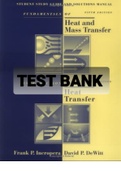PROBLEM 1.1 KNOWN: Heat rate, q, through one-dimensional wall of area A, thickness L, thermal conductivity k and inner temperature, T 1. FIND: The outer temperature of the wall, T 2. SCHEMATIC: ASSUMPTIONS: (1) One-dimensional conduction in the x-direction, (2) Steady-state conditions, (3) Constant properties. ANALYSIS: The rate equation for conduction through the wall is given by Fourier’s law, qq q A = - kdT
dxA=kATT
Lcond xx12==′′⋅⋅−. Solving for T 2 gives TTqL
kA21cond=− . Substituting numerical values, find TC -3000W 0.025m
0.2W/m K 10m2 2=×
⋅×415/G24 T C-37.5 C2=415/G24/G24 TC .2=378/G24 < COMMENTS: Note direction of heat flow and fact that T 2 must be less than T 1. PROBLEM 1.2 KNOWN: Inner surface temperature and thermal conductivity of a concrete wall. FIND: Heat loss by conduction through the wall as a function of ambient air temperatures ranging from -15 to 38°C. SCHEMATIC: ASSUMPTIONS: (1) One-dimensional conduction in the x-direction, (2) Steady-state conditions, (3) Constant properties, (4) Outside wall temperature is that of the ambient air. ANALYSIS: From Fourier’s law, it is evident that the gradient, x dT dx q k ′′=− , is a constant, and hence the temperature distribution is linear, if xq′′ and k are each constant. The heat flux must be constant under one-dimensional, steady-state conditions; and k is approximately constant if it depends only weakly on temperature. The heat flux and heat rate when the outside wall temperature is T 2 = -15°C are ()2 12x25 C 15 CdT T Tq k k 1W m K 133.3W mdx L 0.30m−−−′′=− = = ⋅ =/G24/G24
. (1) 22xxq q A 133.3W m 20m 2667W′′=× = × = . (2) < Combining Eqs. (1) and (2), the heat rate q x can be determined for the range of ambient temperature, -15 ≤ T2 ≤ 38°C, with different wall thermal conductivities, k. -20 -10 0 10 20 30 40
Ambient air temperature, T2 (C)-1500-500500150025003500Heat loss, qx (W)
Wall thermal conductivity, k = 1.25 W/m.K
k = 1 W/m.K, concrete wall
k = 0.75 W/m.K For the concrete wall, k = 1 W/m ⋅K, the heat loss varies linearily from +2667 W to -867 W and is zero when the inside and ambient temperatures are the same. The magnitude of the heat rate increases with increasing thermal conductivity. COMMENTS: Without steady-state conditions and constant k, the temperature distribution in a plane wall would not be linear. PROBLEM 1.3 KNOWN: Dimensions, thermal conductivity and surface temperatures of a concrete slab. Efficiency of gas furnace and cost of natural gas. FIND: Daily cost of heat loss. SCHEMATIC: ASSUMPTIONS: (1) Steady state, (2) One-dimensional conduction, (3) Constant properties. ANALYSIS: The rate of heat loss by conduction through the slab is () ()12TT 7 Cq k LW 1.4W/m K 11m 8m 4312 Wt 0.20m−°== ⋅ × = < The daily cost of natural gas that must be combusted to compensate for the heat loss is () ()g
d6fqC 4312W $0.01/MJC t 24h/d 3600s/h $4.14/d
0.9 10 J/MJ η×=Δ = × =
× < COMMENTS: The loss could be reduced by installing a floor covering with a layer of insulation between it and the concrete.




